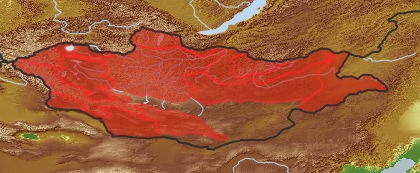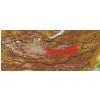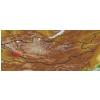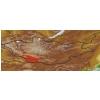| Class: | angiosperms |
| Order: | Caryophyllales |
| Family: | Plumbaginaceae |
| Genus: | Goniolimon |
| Scientific name: | Goniolimon speciosum (L.) Boiss. |
| Name acc. to: | Gubanov 1996 |
| Herbar: | list records    |
| Description: | Leaves glabrous, broad lanceolate-ovate, 2.5-6(8) x 2-3 cm, without lime dots. Inflorescence dense, capitate at branch apexes, branches forming narrow-pyramidal panicle, bracts 7-8 mm long. Calyx lobes entire. |
| Confuse with: | Small plants without flowers maybe confused with Limonium flexuosum. |
| Link to Flora of China: | http://www.efloras.org/browse.aspx?flora_id=2&name_str=Goniolimon+speciosum |
| open map in a new window |  |
| Habitat: | Steppe and desert debris and stony slopes, rocks, pebbles (Grubov 2001). |
| Habit (i)general appearance of a plant | |
| Growth form: (i)Herb, shrub, tree or climber. | herb (i)Herbaceous, erect plant, up to 2m high, mostly with a leafy shoot; if perennial, shoots die to the ground each season, shoots are not woody
example: Artemisia pectinata   inherited by family Plumbaginaceae: herb inherited by family Plumbaginaceae: herb
|
| Parasite status: (i)Is the plant a half- or full parasite? | no parasite/saprophyte (i)Plant fully autonomous, leaves with chlorophyll
example: Most plants, Ranunculus  inherited by family Plumbaginaceae: no parasite/saprophyte inherited by family Plumbaginaceae: no parasite/saprophyte
|
| Water or terrestrial plant: (i)Where do the plants grow? | terrestrial (i)Plant grows on dry land
example: Orostachys spinosa  inherited by family Plumbaginaceae: terrestrial inherited by family Plumbaginaceae: terrestrial
|
| Leaf (i)expanded, usually photosynthetic organ of a plant (including phylloclades) | |
| Leaf development: (i)Structure and development of leaves. | with green leaves (i)Plant with green leaves  inherited by genus Goniolimon: with green leaves inherited by genus Goniolimon: with green leaves
|
| Leaf arrangement: (i)Arrangement of leaves at the stem. | basal rosette (i)Leaves positioned at the base of the stem; stem often without leaves, no visible internodes (but flowers often on erect stems, and these may have few leaves)
example: Limonium, Potentilla, Plantago; also used in Liliales with basaly crouwded leaves (Tofieldia, Zigadenus etc.)   inherited by family Plumbaginaceae: basal rosette inherited by family Plumbaginaceae: basal rosette
others ? (i)Not as above (soll gelöscht werden)  inherited by family Plumbaginaceae: others ? inherited by family Plumbaginaceae: others ?
|
| Simple or divided leaves: (i)Are the leaves simple or completely divided in several parts? Blade of the leaf entire or (more or less) deeply dissected. Attention: There are various appearances of the leaf margin (from entire to toothed and lobed). Here, we ignore this and ask only for dissections that separate the leaf for more than one third of its length or width, whatever is smaller. Sometimes, it is difficult to tell apart compound leaves from a shoot system with simple leaves: look for stipulae and/or axillary buds at the ground of the leaves: if only some possess these structures, the others are most likely leaflets of a compound leaf. | simple (i)Non-divided leaf, but margin may be incised nearly to the ground   inherited by family Plumbaginaceae: simple inherited by family Plumbaginaceae: simple
|
| Shape of blade: (i)Easy for simple leaves. In compound leaves use the general shape of leaflet. Always check the ground for largest leaves of a plant. To be worked out: how to handle pinnate leaves? | elliptic (including ovate and obovate) (i)Elliptic: broadest at the middle and narrower at the two equal ends; ovate: egg-shaped, attached at the broad end; obovate: attached at the narrower end
example: Limosella aquatica   inherited by genus Goniolimon: elliptic (including ovate and obovate) inherited by genus Goniolimon: elliptic (including ovate and obovate)
lanceolate (i)Lance-shaped; much longer than wide, with the widest point in the middle or below 
|
| Length of leaves: (i)How long is the leaf, be carefull in compound leaves, measure the complete leaf. | from 21 mm to 50 mm
more than 50 mm
|
| Leaf apex: (i)Appearance of the tip of leaf resp. leaflets in compound leaves. | aristate (i)Bearing a more or less distinctive bristle as appearing as continuation of the main vein at the tip
example: Galium verum  
|
| Leaf margin: (i)Structure of leaf margin (or that of a leaflet in case of compound leaves). Attention: Here we ask for the leaf margin, defined as all those dissections that separate the leaf for less than one third of its length or width, whatever is smaller. To be worked out: how to handle margin of pinnate leaves? | entire (i)Plain margin, not toothed
example: Iris   inherited by family Plumbaginaceae: entire inherited by family Plumbaginaceae: entire
|
| Leaf base: (i)The angle the leaf blade forms with a real or imaginary (sessile leaves) petiole. Attention: Here, we consider only the base of leaves or leaflets (in case of compound leaves). | narrow (i)Angle < 30° 
|
| Stipule: (i)Leaflets at the base of the petiole, these are smaller and of different shape. | none (i)Without stipules
example: Euphorbia, Ericaceae s.l.  inherited by family Plumbaginaceae: none inherited by family Plumbaginaceae: none
|
| Leaf colour upper side: (i)Shades of green on the leaf, upper side. | green (i)Clear green
example: Tribulus terrestris
grayish (i)Grayish in colour due to hairs or a thick cuticula
|
| Leaf colour lower side: (i)Shades of green on the leaf, lower side. | green (i)Clear green, in most species
example: Angelica decurrens
grayish (i)Grayish in colour due to hairs or a thick cuticula
example: Atriplex cana
|
| Leaf veination: (i)Arrangement of the main veins of a leaf. | pinnate (i)One main vein, several side veins, sometimes inconspicuous
example: Cicerbita     inherited by family Plumbaginaceae: pinnate inherited by family Plumbaginaceae: pinnate
|
| Flower (i)reproductive portion of the plant, consisting of sepals, petals, stamens, and pistils | |
| Flower appearance and pollination: (i)General appearance of the flower. | attractive, animal-pollinated (i)attractive and coloured flowers, mostly large, attracting surely animals
example: Trollius, Rosa, Chamaerhodos  inherited by family Plumbaginaceae: attractive, animal-pollinated inherited by family Plumbaginaceae: attractive, animal-pollinated
|
| Flower colour: (i)Attention: assess colour of the most colourful parts of the flower, but not of the stamens; be aware of single plants with a mutation (mostly white) on flower colour. | white (i)Most plants of the population white
example: Pleurospermum, Maianthemum
yellow to orange (i)Pale to golden yellow
example: Ranunculus, Crepis
pink (i)Between red and white
example: Centaurium
|
| Perianth arrangement: (i)Attention: in some plants, flowers may be dimorphic in different ways (dioecious or gynodioecious). If flowers vary, record the characters of the most showy flowers. | double, different (i)Two types of perianth leaves, differently coloured (sepals: outer periant leaves, usually greenish, and petals: inner perianth leaves, usually coloured)
example: Parnassia    inherited by family Plumbaginaceae: double, different inherited by family Plumbaginaceae: double, different
|
| Diameter of flower: (i)Diameter of flower or flower head. | to 5 mm (i)
example: Aruncus
from 5 mm to 10 mm (i)
example: Stellaria
|
| Flower symmetry: (i)Symmetry of the perianth leaves. Attention: to assess this character, look on sepals, petals and stamens, but neglect carpels and ovary. | radiary, regular (actinomorphic) (i)More than two axis of symmetry
example: Saxifraga: 5; Iris: 3   inherited by family Plumbaginaceae: radiary, regular (actinomorphic) inherited by family Plumbaginaceae: radiary, regular (actinomorphic)
|
| Flower form: (i)common forms of flowers ? Veronica | simple (flat) - Do not confuse with inflorescences as in some Asteraceae (i)Petals spread out, flower appearing flat
example: Mollugo, Trientalis, Pulsatilla, Saxifraga   inherited by family Plumbaginaceae: simple (flat) - Do not confuse with inflorescences as in some Asteraceae inherited by family Plumbaginaceae: simple (flat) - Do not confuse with inflorescences as in some Asteraceae
tubular to funnel-shaped (i)Petals form a tube, are often partially united to a cylindrical corolla, often surrounded by a calyx   inherited by family Plumbaginaceae: tubular to funnel-shaped inherited by family Plumbaginaceae: tubular to funnel-shaped
|
| Sepal number: (i)Number of sepal leaves (outer perianth leaves, calyx leaves, mostly greenish). Attention, this character applies only for flowers separated in sepals and petals, thus excluding most monocots. Be aware of the bracts (involucral leaves) of Asteraceae flowerheads, do not qualify these as sepals! Be also aware in Rosaceae is often an epicalyx developed, in this case count all parts. | 5 (i)
example: Polemonium  inherited by family Plumbaginaceae: 5 inherited by family Plumbaginaceae: 5
|
| Sepal fusion: (i)To which degree are the sepal leaves connected? Attention, this character applies only for flowers separated in sepals and petals, thus excluding most monocots. Be aware of the bracts (involucral leaves) of Asteraceae flowerheads, do not qualify these as sepals! | fused at base (i)Leaves with a joint base, but fused over not more than half of the entire length
example: Campanula  inherited by family Plumbaginaceae: fused at base inherited by family Plumbaginaceae: fused at base
|
| Petal / Tepal number: (i)Number of petal leaves (inner perianth leaves, usually coloured). | 5 (i)
example: Potentilla  inherited by family Plumbaginaceae: 5 inherited by family Plumbaginaceae: 5
|
| Petal / Tepal fusion: (i)To which degree are the petal leaves connected? Petals sympetalous. | free (i)all petal leaves separate from each other
example: Anthriscus  inherited by family Plumbaginaceae: free inherited by family Plumbaginaceae: free
fused at base (i)petal leaves with a joint base, but fused over not more than 50% of the entire length
example: Myosotis, Pedicularis, Cortusa  inherited by family Plumbaginaceae: fused at base inherited by family Plumbaginaceae: fused at base
fused (i)petal leaves united, only tips are free (gamopetalous, sympetalous)
example: Linnaea, Adenophora, Stellera  inherited by family Plumbaginaceae: fused inherited by family Plumbaginaceae: fused
|
| Spur: (i)A hollow, slender, sac-like appendage of the perianth leaves, storing nectar. | no spur (i)Flower without appendage
example: Peganum  inherited by family Plumbaginaceae: no spur inherited by family Plumbaginaceae: no spur
|
| Stamen number: (i)Attention: We ask for the reproductive organs of the flower dispersing pollen. Count only fully fertile stamens, not staminodia (e.g. Parnassia). | 5 (i)
example: Peucedanum  inherited by family Plumbaginaceae: 5 inherited by family Plumbaginaceae: 5
|
| Stamen fusion: (i)To which degree are the stamens fused? Attention: Whereas the pollen sacs itself are often free., their stalks (filaments) may be fused. Here, we count them as fused if they are together over at least one thirth of their length. | free (i)Stamens with separate bases
example: Malus  inherited by family Plumbaginaceae: free inherited by family Plumbaginaceae: free
fused with a corolla (calyx in Thymelaeaceae) (i)Stamens with perianth leaves at least one third of the length of the filament
example: Orobanche, Salvia, Stellera  inherited by family Plumbaginaceae: fused with a corolla (calyx in Thymelaeaceae) inherited by family Plumbaginaceae: fused with a corolla (calyx in Thymelaeaceae)
|
| Pistil number: (i)Number of pistils (female floral organs: style, if developed; stigma and carpels/ovary together build the pistil). | 5 (i)Five stigmas, usually in a whorl
example: Cerastium  inherited by family Plumbaginaceae: 5 inherited by family Plumbaginaceae: 5
|
| Carpel fusion: (i)To which degree are the carpels (modified leaf forming simple pistil or part of a compound pistil) fused. | fused (i)Carpels united into an ovary, only styles are free
example: Malus, Berberis  inherited by family Plumbaginaceae: fused inherited by family Plumbaginaceae: fused
|
| Style number: (i)Portion of the pistil connecting the stigma to the ovary. | 5  inherited by genus Goniolimon: 5 inherited by genus Goniolimon: 5
|
| Ovary position: (i)For entirely or partly fused carpels, describe their position in relation to the insertion point of perianth leaves (best done by doing a longitudinal section of a flower). | superior (hypogynous) (i)Base of carpels attached above insertion point of perianth leaves, carpels free or fused
example: Delphinium, Anemone    inherited by family Plumbaginaceae: superior (hypogynous) inherited by family Plumbaginaceae: superior (hypogynous)
|
| Sex: (i)Distribution of male and female organs among flowers, only most commonly cases. | bisexual, hermaphrodite (i)All or nearly all flowers of a plant with male and female parts
example: Haplophyllum, Chenopodium  inherited by family Plumbaginaceae: bisexual, hermaphrodite inherited by family Plumbaginaceae: bisexual, hermaphrodite
|
| Fruit (i)the seed bearing organ, with or without adnate parts; a ripened ovary and any other structures which are attached and ripen with it. Aggregate fruits are handled like simple fruits for determination. | |
| Consistency: (i)Fleshy fruits or dry fruits, see dispersal adaptations for further classification. | dry (i)With a dry outer shell, no fleshy parts, but seed (embryo) could be edible  inherited by family Plumbaginaceae: dry inherited by family Plumbaginaceae: dry
|
| Type of fruit: (i)Common fruit types (including pseudocarp). | Solitary fruits (i)     inherited by family Plumbaginaceae: Solitary fruits inherited by family Plumbaginaceae: Solitary fruits
capsule (i)Dry dehiscent fruit, releasing seeds by slits or holes.
example: Poppy, most Caryophyllaceae, Cerastium, a lot of Scrophulariaceae, Iris (oppened capsule looks like Delphinium), Zygophyllum - it is a very common fruit type     inherited by family Plumbaginaceae: capsule inherited by family Plumbaginaceae: capsule
Dehiscent fruits (i)Fruits open along a longitudinale line (except silicula)  inherited by family Plumbaginaceae: Dehiscent fruits inherited by family Plumbaginaceae: Dehiscent fruits
|
| Opening of fruit: (i)Mode of dehiscence at maturity to release seeds. | not opening / indehiscent (i)Fruits remain closed at maturity and disperse with seeds inside
example: Corylus (nut), Vaccinium (berry)  inherited by family Plumbaginaceae: not opening / indehiscent inherited by family Plumbaginaceae: not opening / indehiscent
|
| Root / shoot below ground (i)plant part below ground (in most cases), including below ground shoots, without leaves | |
| Root type: (i)Organisation of the roots. | allorhizous (i)Plant with a conspicuous tap root, one larger tap root with side roots
example: Dicotyledonae  inherited by order Caryophyllales: allorhizous inherited by order Caryophyllales: allorhizous
|
| Distribution (i)region where the plant is likely to be found | |
| Distribution (Veg. Zones): (i)acc. to Grubov 1952 | Khubsgul (i)In distribution data often named as '1' 
Khentei (i)In distribution data often named as '2' 
Khangai (i)In distribution data often named as '3' 
Mongol-Daurian (i)In distribution data often named as '4' 
Great Khingan (i)In distribution data often named as '5' 
Khobdo (i)In distribution data often named as '6' 
Mongolian Altai (i)In distribution data often named as '7' 
Middle Khalkha (i)In distribution data often named as '8' 
East Mongolia (i)In distribution data often named as '9' 
Depression of Great Lakes (i)In distribution data often named as '10' 
Gobi-Altai (i)In distribution data often named as '13' 
Dzungarian Gobi (i)In distribution data often named as '14' 
Transaltai Gobi (i)In distribution data often named as '15' 
|
| Distribution Khangay: (i)acc. Flora Khangaya 1989 | I
II
III
IV
V
VI
|